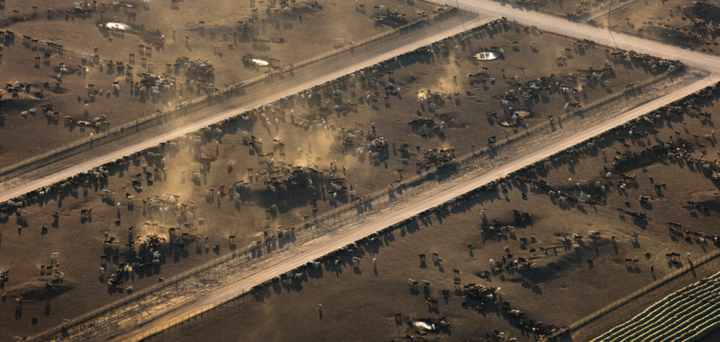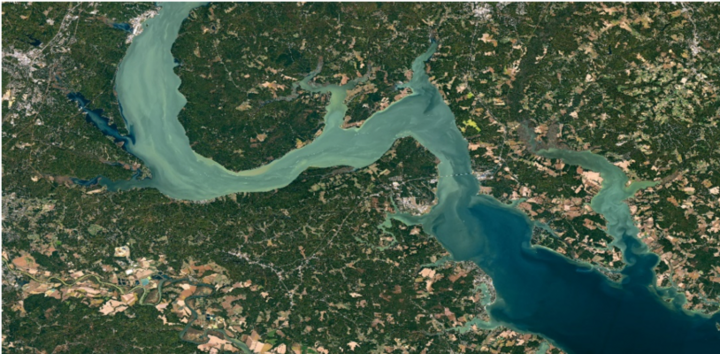Manure Phosphorus and Water Quality
How does the Phosphorus from Manure Runoff Effect our Streams, Reservoirs, and Lakes?
Justin Caniglia
This article is written by a University of Nebraska-Lincoln student, Justin Caniglia, as part of their Animal Manure Management class in Biological Systems Engineering. It has been reviewed by experts to encourage accuracy of issues presented. The article represents the student’s understanding of the subject addressed at this stage in her career. Rick Koelsch, faculty instructor.
Manure produced in animal feeding operations is a source of fertilizer that can be used to reduce our dependency on commercial fertilizers. Manure contains several essential nutrients that crops that crops rely on to grow, most notably nitrogen and phosphorus. Proper management of manure before, during, and after land application helps to slow down the contamination of our streams and reservoirs. Improper land application and management of manure increases the probability of this manure, along with high concentrations of phosphorus, to enter our streams and reservoirs. Phosphorus can cause numerous problems in our waterbodies.
Today’s article will focus on the following
- Managing the nutrient content of manure
- Effects of Phosphorus in the environment
- Possible Solutions, including erosion control, to decrease phosphorus in our streams

Why is the Manure Management Important to You?
Manure is an economic and sustainable way to fertilize crop ground. Animal feeding operations that can apply the manure on crop fields can help keep vital nutrients recycling through their operations. Manure can reduce an agricultural producers’ reliance on commercial fertilizers, while also allowing you to sell this manure to make an economic gain. This ability of producing cattle feed by utilizing the nutrients in cattle manure, is a win-win by keeping nutrients in the operation and out of surface waters.
Nutrient content of the feed can have a drastic impact on the nutrient content of manure. For example, if the phosphorus content in feed is high this will cause manure to be high in phosphorus. So, controlling the nutrients of the feed allows for the control of nutrients found in manure. The nutrient content of the manure can affect how you manage the land-application of this manure, as too much phosphorus in the soil can lead to the excess phosphorus in our waterbodies. Properly managed manure can deliver you and your community both economic and environmental benefits.
What Happens When Phosphorus Enters Our Environment?
Phosphorus can enter our environment and harm our stream and reservoirs. Phosphorus can adsorb to soil particles, this type of phosphorus is known as soil test phosphorus (STP). Applying manure to meet nitrogen demands may lead to adding too much phosphorus to the field or high STP. Soil erosion is the main route for phosphorus to enter the streams, as much of phosphorus is attached to soil particles. If STP is high, dissolved phosphorus can be a large contributor to the environment as well.
Once phosphorus enters our stream systems it can cause a complex network of problems. Nitrogen and phosphorus are limiting nutrients for in our aquatic systems, especially autotrophic life (algae, cyanobacteria). Regulating phosphorus has shown the ability to decrease these algae blooms in many systems, showing evidence of the key role of phosphorus in our ecosystems. A high flux of phosphorus into our streams can cause exponential growth of algae, otherwise known as an algae bloom. These algae blooms are more than just aesthetically unpleasing as shown in Figure 2. Algae blooms can cause hypoxia and different types of algae can release toxins that can be harmful to fish and damage ecosystems.

Chesapeake Bay and the Gulf of Mexico are prime examples of what large inputs of nutrients, specifically what phosphorus can do to our surface water systems5. Watershed urban landscapes and agricultural practices increase the amount of phosphorus found in surface water and resulting algae blooms. Algae blooms cause hypoxia (oxygen depletion of water), release toxins, and thus cause fish kills damaging the ecosystem and the livelihood of fisherman. Lakes are very susceptible to algae blooms due to an increase in phosphorus content, which leads to loss of fish.
BMP’s for Managing Phosphorus
Practices for controlling erosion are critical to manure management. USDA and other natural resource agencies provide incentives to assist agricultural producers and landowners in transitioning in implementing these BMPs. These practices will help limit soil erosion and decrease the amount of phosphorus that enters our surface water systems.
What is needed:
- Proper Management of Manure
- Proper Management of Land Applications
- Erosion Control Using BMPs
Using BMPs including manure application rate, no till, buffer zones, terracing, and timing of manure application should be considered for decreasing soil erosion. This soil erosion is a huge source of phosphorus and sediment into our water systems. A great solution to decreasing the phosphorus content in our streams is to slow down erosion. In addition, decreasing the nutrient content of your feed will allow for a decrease in nutrient content of manure excreted. Decreasing nutrient concentration of feed to point where livestock needs are still met will allow you to meet you crop nutrient needs, livestock needs, and decrease possible losses into the environment. Managing of manure is an intense process and should not be taken lightly. Proper management practice can increase your gains economically and environmentally.
Where do we go From Here?
As farmers and others may know, managing a feed operation takes a lot of time, work, and knowledge. The important topic of managing manure to improve the water quality of our waterbodies is shown here. Protecting everyone’s health and livelihoods is of utmost importance, from farmers to fisherman. This can be done by decreasing the amount of phosphorus that enters into our streams, with the help of BMPs, feed nutrient control, and educational experiences. I propose this by:
- Learning the advantages and disadvantages of practices that slow the erosion of soil that is laden with phosphorus.
- Managing nutrient content of feed and direct effects on content found in manure.
- Discussing my experiences through public outreach systems and educational avenues.
To get more information and help with farm specific problems, please visit NDEE’s livestock program webpage, NRCS, private sector consultants, extensions and references found at end of the document. Links and references can be found below.
Additional Reading/Informative Avenues
- A.L, H., P., G., & R.J., P. (1998). Nitrogen and phosphorus in runoff from grassland with buffer strips following application of fertilizers and manures (pp. 142–148). British Society of Soil Science.
- Lory, J. A. (2002). Managing Manure Phosphorus to Protect Water Quality (pp. 1–6). MU Extension.
- Maguire, R. O., Dou, Z., Sims, J. T., Brake, J., & Joern, B. C. (2005). Dietary Strategies for Reduced Phosphorus Excretion and Improved Water Quality. In Journal of Environmental Quality (Vol. 34, Issue 6, pp. 2093–2103). https://doi.org/10.2134/jeq2004.0410
- McDowell, R., & Sharpley, A. (2002). Phosphorus Transport in Overland Flow in Response to Position of Manure Application. In Journal of Environmental Quality (Vol. 31, Issue 1, pp. 217–227). https://doi.org/10.2134/jeq2002.2170
- Correll, D. L. (1999). Phosphorus: A rate limiting nutrient in surface waters. Poultry Science, 78(5), 674–682. https://doi.org/10.1093/ps/78.5.674
- NDEE’s Livestock Program http://dee.ne.gov/NDEQProg.nsf/%24%24OpenDominoDocument.xsp?documentId=79575E854F28F92786257CAE0070F062&action=openDocument, Contact NDEE’s field office
References:
- A.L, H., P., G., & R.J., P. (1998). Nitrogen and phosphorus in runoff from grassland with buffer strips following application of fertilizers and manures (pp. 142–148). British Society of Soil Science.
- Lory, J. A. (2002). Managing Manure Phosphorus to Protect Water Quality (pp. 1–6). MU Extension.
- Maguire, R. O., Dou, Z., Sims, J. T., Brake, J., & Joern, B. C. (2005). Dietary Strategies for Reduced Phosphorus Excretion and Improved Water Quality. In Journal of Environmental Quality (Vol. 34, Issue 6, pp. 2093–2103). https://doi.org/10.2134/jeq2004.0410
- McDowell, R., & Sharpley, A. (2002). Phosphorus Transport in Overland Flow in Response to Position of Manure Application. In Journal of Environmental Quality (Vol. 31, Issue 1, pp. 217–227). https://doi.org/10.2134/jeq2002.2170
- Correll, D. L. (1999). Phosphorus: A rate limiting nutrient in surface waters. Poultry Science, 78(5), 674–682. https://doi.org/10.1093/ps/78.5.674
This article was reviewed by Javed Iqbal, Nebraska Extension Specialist and Michael Sindelar, Nebraska Extension Educator